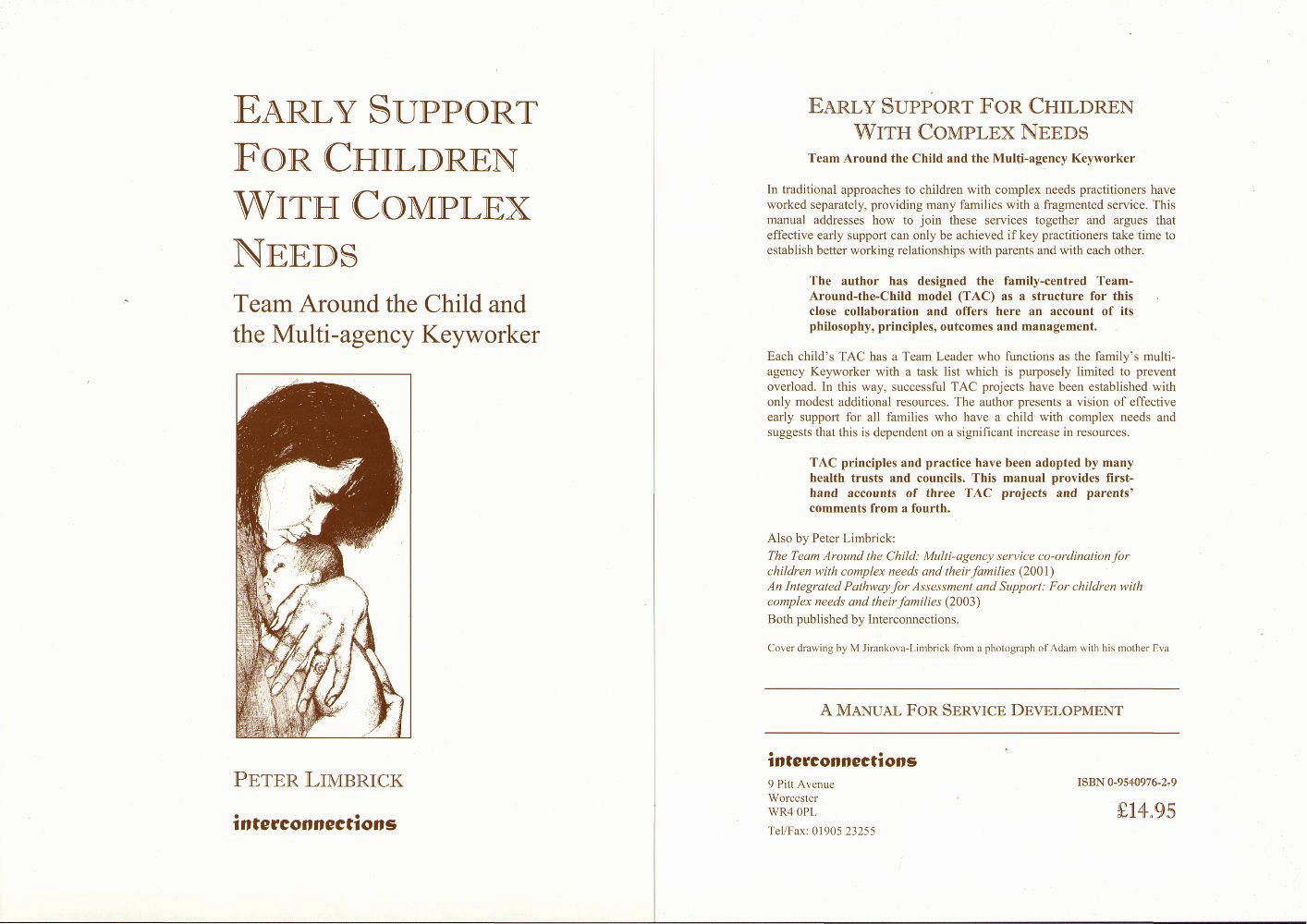Early Support for Children with Complex Needs: Team Around the Child and the Multi-agency Keyworker. Free PDF of the whole book
A manual for service development by Peter Limbrick 2004
Introduction
For many years parents of children with disabilities who have multiple or complex needs have been complaining about services being unco-ordinated and fragmented and about their children being treated in separate bits.
There is now a general recognition of these real problems and, in an endeavour to remedy them, service managers, practitioners, parents, and disabled young people and adults in many localities are exploring initiatives variously named ‘service co-ordination’, ‘care co-ordination’, ‘integration of services’, ‘multi-agency working’, ‘joint working’, ‘harmonisation of support’, etc. So that we can keep our focus on actual outcomes, we should think of these initiatives only as means to an end. They are not ends themselves.
The end product we are all striving for is effective support for children and young adults with multiple disabilities and complex needs. For the purposes of this service
The need for joined-up support
Many parents speak of the great difficulties they experienced during the first weeks, months and years after they learned of their child’s condition. When I ask such parents what would have most helped them at that time, they often say they would have liked to have all the separate services linked together in some way.
Many parents deeply resent the confusion, repetition, gaps and chaos they experience in fragmented services. One parent spoke of her baby of nine months being spread in bits all around the city and not belonging to her anymore. She felt demoralised and helpless. Two therapists meeting for the first time in a young child’s first TAC meeting discovered that one was teaching the child to stay put and use a sign when he wanted something while the other was teaching the child to go and get whatever he wanted himself. These are both valid goals: the first to promote communication and the second to encourage movement, but they cannot be used together without very careful planning. An effective joined-up service will have both co-ordination of visits, clinic appointments, etc. and integration of the young child’s programmes.
The effect of fragmentation
In the first months and years families can be very vulnerable. We cannot assume the family will survive intact any more than we can assume the child will. It is not helpful to push and pull parents in different directions in their pursuit of effective support, to divide the child up into separate bits for treatment, to focus exclusively on the child as though he or she existed independently of the family or to deny parents a voice in how support is provided. Such an outdated approach makes life even more difficult for parents who, like the rest of us, just want to secure what is best for their child and family.
The traditional fragmented approach to these children can damage families at a time when they are very vulnerable. A fragmented service is characterised by:
* a chaotic routine of appointments, home visits and consultations with little or no consideration of time, place and travel arrangements
* duplications of some elements of assessment and support and a lack of others
* conflicting diagnoses, information and advice
* advice, suggestions and home programmes overloading parents
* programmes and goals which are discipline-specific and do not fit together
Families suffer under fragmented services. Instead of smoothing the way for families, services which are delivered piecemeal create hurdles for them to clamber over and hoops to jump through. As a result families can experience additional and unnecessary stresses and strains. As they struggle to get their real needs met they are forced to waste valuable time, money and mental and physical energy. Their strategies for coping and their efforts to adapt are impeded. The child in this exhausted and stressed family will almost certainly be affected. He or she might, as a result, have a reduced capacity to benefit from treatment, therapy and education and consequent increased vulnerability. Practitioners, no matter how skilled and motivated they are, must face the possibility that the fragmented arena in which they operate significantly reduces their effectiveness.
The impact of a child’s complex needs can be pervasive and all aspects of family life can be affected. We should acknowledge that services cannot offer total support to any family. Support will always be limited and, in some cases, practitioners will only be able to help by accompanying the family for a time on a very difficult journey. No practitioner can protect a family from all the challenges they face and, even if they could, this would not be desirable. Any family subject to such all-embracing support would lose its integrity and its opportunities for learning and development. It is important, for the sake of practitioners’ mental health, to acknowledge these limitations. At the same time, it is even more important for managers and practitioners to monitor their practice to make sure they are not making life harder than it need be for children and families.
The whole book is offered here as a free PDF:
https://tacinterconnections.com/images/EarlySupportBook.pdf


